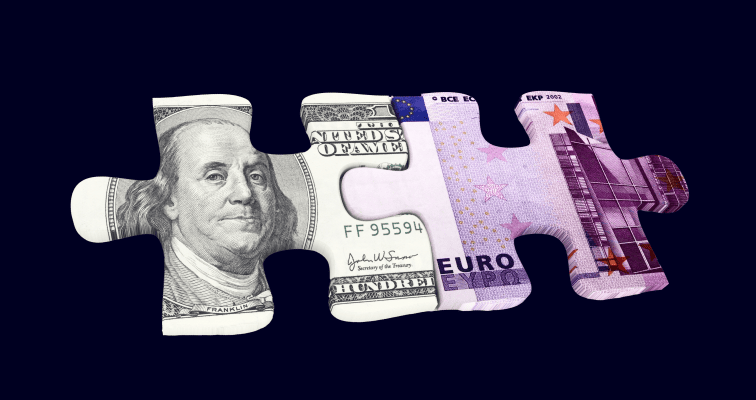Currency markets are popular among traders and investors, but some of the terminology can seem a little complicated at first. Discover what a currency pair is and what the difference is between a major and a minor currency pair.
According to estimates, there are more than 10 million people trading forex globally. Currency markets are easy to access, price moves are largely intuitive and, because of the volume of trading activity, fees and commissions are low.
Before booking your first forex trade, it is worth developing a better understanding of the basic terms involved, such as “currency pair.” Understanding this terminology will provide you with the best possible foundation for trading forex.

What is a currency pair?
A currency pair is a financial instrument that can be bought and sold on a currency exchange. Each pair is made up of two currencies. For example, the euro and the US dollar are referred to as “Eurodollar” and trade under the ticker symbol EURUSD.
Currency pairs enable traders to take a view on how the relative value of two currencies will change over time. When booking a trade, the decision to “buy” or “sell” relates to the first currency of the ticker. In the case of the GBPUSD currency pair, executing a “buy” trade will result in an investor simultaneously buying British pounds and selling US dollars. On the other hand, a “sell” trade would result in a short position in GBP and a long position in USD.
Tip: The first currency referenced in a currency pair ticker is known as the base currency, and the second is known as the quote currency.

The most traded currency pairs
According to estimates, around $6tn worth of currency trades are transacted on a daily basis, and, on average, the EURUSD currency pair makes up approximately a quarter of the total market.
The size of two economies will often be reflected in the trading volume of their currency pairs, hence, why EURUSD dominates the market. Most of the day-to-day trading activity in currencies will be carried out by participants in the “real” economy, who exchange currencies to help them carry out their business activities.
Forex pairs
Many currency pairs have nicknames and are grouped into different categories:
- Major
- Minor
- Exotic
The categorisation of currency pairs is based primarily on the size of the market, although beginner traders should be aware that it is an informal process, meaning there are some grey areas and room for crossover. All currencies have different characteristics, and the filtering of currency pairs into categories is done so that investors understand what kind of market conditions to expect.
Major forex pairs
The tickers of the major currency pairs are EURUSD, USDJPY, GBPUSD and USDCHF. These forex pairs are ranked as such due to the high trading volumes seen in each market, as well as for historical reasons. For example, the Swiss franc is widely bought as a safe-haven asset. Unsurprisingly, as the US economy is the largest economy in the world, all of the major currency pairs include USD.
| Major Currency Pairs |
| Ticker | Currencies | Nickname | Approx % of Global Forex Market (2022) |
|---|---|---|---|
| EURUSD | Euro / US dollar | Fiber | 24% |
| USDJPY | US dollar / Japanese yen | Ninja | 13% |
| GBPUSD | British pound / US dollar | Cable | 10% |
| USDCHF | US dollar / Swiss franc | Swissie | 4% |
Tip: The four “major” currency pairs make up approximately half of the global forex market. The high trade volumes and excellent liquidity levels make them popular with beginner traders.
Minor forex pairs
Minor currency pairs include at least one of the world’s main currencies, excluding the US dollar. This includes the euro, the British pound and Japanese yen. There are a greater number of minor currency pairs than major pairs, with more possible permutations available. Popular minor forex pair markets include GBPCHF, SGDJPY and EURCAD.
| Minor Currency Pairs |
| Ticker | Currencies | Nickname |
|---|---|---|
| EURGBP | Euro / British pound | Chunnel |
| GBPJPY | British pound / Japanese yen | Guppy |
| EURJPY | Euro / Japanese yen | Yuppy |
Exotic forex pairs
Exotic currency pairs involve a currency from a large, developed country and a currency with a far smaller trade volume. Different traders have varying opinions about the line between minor currency pairs and exotics, but there are some minor currency pairs widely accepted as the latter.
| Exotic Currency Pairs |
| Ticker | Currencies | Nickname |
|---|---|---|
| USDRUB | US dollar / Russian ruble | Barney |
| USDNOK | US dollar / Norwegian krone | Noki |
| USDSEK | US dollar / Swedish krone | Stoki |
Risk comes from not knowing what you are doing.
Warren Buffett
Commodity forex pairs
Commodity pairs include currencies of countries that have large commodity reserves. The price of a commodity currency can be greatly influenced by the price of the commodities exported by that country.
The Australian dollar is a commodity currency. Its value increases and decreases as international counterparts buy the “Aussie” dollar, which is then used to purchase the copper, coal, aluminium and gold that Australia mines and exports. Other commodity currencies include USDCAD and NZDUSD, although some investors also consider these commodity currencies to be major currency pairs.
| Commodity Currency Pairs |
| Ticker | Currencies | Nickname |
|---|---|---|
| USDCAD | US dollar / Canadian dollar | Loonie |
| AUDUSD | Australian dollar / US dollar | Aussie |
| NZDUSD | New Zealand dollar / US dollar | Kiwi |
Forex cross pairs
Cross pairs are currency pairs that don’t include the US dollar. For example, the euro-yen is a cross pair, as well as a minor currency pair. Instead of booking two trades and converting euros into dollars, and then dollars into yen, traders can exchange euros directly with yen, hence the term “cross.”
| Forex Cross Pairs |
| Ticker | Currencies |
|---|---|
| EURCAD | Euro / Canadian dollar |
| CHFJPY | Swiss franc / Japanese yen |
| GBPAUD | British pound / Australian dollar |
Tip: As the relative value of the currencies changes, traders holding positions will report a profit or loss on their position. Regardless of the currency pair you decide to trade, this is the fundamental principle to remember.

Final thoughts
Any two currencies can be traded against one another, but those new to forex trading — who want to take advantage of free research and low trading costs — might find major currency pairs to be one of the best options available.
Visit the eToro Academy to learn more about currency pairs and forex trading.
Quiz
FAQs
- Is EURUSD the same as USDEUR?
-
It is hypothetically possible to trade USDEUR, rather than EURUSD. In both instances you would trade the euro vs the dollar, but the base and quote currencies will be reversed. For largely historical reasons, most of the trading activity in pairs of currencies will be done in one form of the ticker, in this case, EURUSD. It is usually recommended that you trade in the most liquid market available.
- Who decides if a currency pair is major, minor, or exotic?
-
The grouping of currency pairs is done informally and is driven by the way they are regarded by traders. If traders or investors start treating a currency pair differently, it can move from one category to another. As an economy becomes more influential, and the currency is traded at a higher volume, it might become more widely regarded as a minor, rather than an exotic currency pair.
- How many currency pairs are there?
-
Technically, any currency can be paired with another, so there are hundreds of different currency pairs in existence. Smaller currencies can be discontinued, which means the number of exotic pairs available to trade is liable to change. There are at least four major currency pairs, but some people argue that there could be as many as seven: EURUSD, USDJPY, GBPUSD, USDCHF, AUDUSD, USDCAD and NZDUSD.
This information is for educational purposes only and should not be taken as investment advice, personal recommendation, or an offer of, or solicitation to, buy or sell any financial instruments.
This material has been prepared without regard to any particular investment objectives or financial situation and has not been prepared in accordance with the legal and regulatory requirements to promote independent research. Not all of the financial instruments and services referred to are offered by eToro and any references to past performance of a financial instrument, index, or a packaged investment product are not, and should not be taken as, a reliable indicator of future results.
eToro makes no representation and assumes no liability as to the accuracy or completeness of the content of this guide. Make sure you understand the risks involved in trading before committing any capital. Never risk more than you are prepared to lose.


